BIOD151
Biod151
All 193 results
Sort by
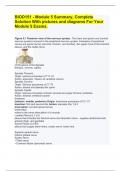
-
BIOD151 - Module 5 Summary, Complete Solution With pictures and diagrams For Your Module 5 Exams.
- Exam (elaborations) • 29 pages • 2024
- Available in package deal
-
- $15.99
- + learn more
BIOD151 - Module 5 Summary, Complete Solution With pictures and diagrams For Your Module 5 Exams. Figure 5.1 Posterior view of the nervous system. The brain and spinal cord (central nervous system) connect to the peripheral nervous system. Examples of peripheral nerves are spinal nerves (cervical, thoracic, and lumbar), the upper trunk of the brachial plexus, and the radial nerve. (3) Divisions of the Spinalis thoracis, cervicis, capitis Spinalis Thoracis Origin: spinous processes ...
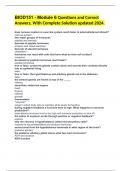
-
BIOD151 - Module 6 Questions and Correct Answers, With Complete Solution updated 2024.
- Exam (elaborations) • 9 pages • 2024
- Available in package deal
-
- $11.49
- + learn more
BIOD151 - Module 6 Questions and Correct Answers, With Complete Solution updated 2024. does nervous system or exocrine system react faster to external/internal stimuli? nervous system two major groups of hormones peptide and steroids derivate of peptide hormones proteins and catecholamines derivate of steroid hormones cholesterol hormones can react with cells that have what on their cell surface? receptors do steroid or peptide hormones react faster? peptide hormones true or false...

-
BIOD151 Module 4 Study Guide Questions with Solutions
- Exam (elaborations) • 20 pages • 2024
-
- $12.94
- + learn more
Skeletal Function The skeleton, comprised of a network of bones held together at joints, has many functions. The skeleton protects vital internal organs. For example, the skull forms a protective encasement for the brain. The rib cage provides protection for the heart and lungs. Flat bones, such as those of the skull, ribs, and breastbone, produce blood cells. All bones are storage areas for inorganic calcium and phosphorus salts. Bones also provide sites for attachment of muscle, tendons,...
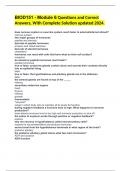
-
BIOD151 - Module 6 Questions and Correct Answers, With Complete Solution updated 2024.
- Exam (elaborations) • 9 pages • 2024
-
- $11.98
- + learn more
BIOD151 - Module 6 Questions and Correct Answers, With Complete Solution updated 2024. does nervous system or exocrine system react faster to external/internal stimuli? nervous system two major groups of hormones peptide and steroids derivate of peptide hormones proteins and catecholamines derivate of steroid hormones cholesterol hormones can react with cells that have what on their cell surface? receptors do steroid or peptide hormones react faster? peptide hormones true or false...

-
BIOD151 Module 3 Exam Questions and Correct Answers, Complete solution 2024.
- Exam (elaborations) • 5 pages • 2024
-
- $9.99
- + learn more
BIOD151 Module 3 Exam Questions and Correct Answers, Complete solution 2024. Two divisions of the digestive system alimentary canal and accessory organs seven parts of the gastrointestinal tract mouth, pharynx, esophagus, stomach, small intestine, large intestine and anus six digestive accessory organs teeth, tongue, gallbladder, salivary glands, liver, pancreas mouth opening lips floor of the mouth tongue walls of the mouth cheeks roof of mouth hard and soft palates two bones a...

-
BIOD151 Module 4 Study Questions with Solutions
- Exam (elaborations) • 8 pages • 2024
-
- $12.24
- + learn more
What are some of the main functions of the skeleton? 1. Protect vital organs 2. Produce blood cells 3. Store inorganic calcium and phosphorus salts 4. Provide sites for attachment of muscles, tendons and ligaments 5. Permit body movement 6. Support the body again the pull of gravity Long Bones Long and thin designed to support body weight and enable movement What are examples of long bones? Humerus, ulna, radias, tibia, fibula, metacarpals, and metatarsals
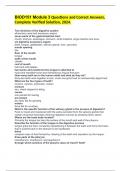
-
BIOD151 Module 3 Questions and Correct Answers, Complete Verified Solution, 2024.
- Exam (elaborations) • 5 pages • 2024
-
- $10.98
- + learn more
BIOD151 Module 3 Questions and Correct Answers, Complete Verified Solution, 2024. Two divisions of the digestive system alimentary canal and accessory organs seven parts of the gastrointestinal tract mouth, pharynx, esophagus, stomach, small intestine, large intestine and anus six digestive accessory organs teeth, tongue, gallbladder, salivary glands, liver, pancreas mouth opening lips floor of the mouth tongue walls of the mouth cheeks roof of mouth hard and soft palates two bo...
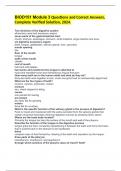
-
BIOD151 Module 3 Questions and Correct Answers, Complete Verified Solution, 2024.
- Exam (elaborations) • 5 pages • 2024
-
- $10.88
- + learn more
BIOD151 Module 3 Questions and Correct Answers, Complete Verified Solution, 2024. Two divisions of the digestive system alimentary canal and accessory organs seven parts of the gastrointestinal tract mouth, pharynx, esophagus, stomach, small intestine, large intestine and anus six digestive accessory organs teeth, tongue, gallbladder, salivary glands, liver, pancreas mouth opening lips floor of the mouth tongue walls of the mouth cheeks roof of mouth hard and soft palates two bo...
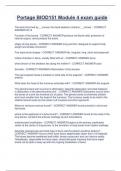
-
Portage BIOD151 Module 4 exam guide
- Exam (elaborations) • 2 pages • 2023
- Available in package deal
-
- $9.99
- + learn more
Portage BIOD151 Module 4 exam guide The skull is formed by___bones; the facial skeleton contains ___bones. - CORRECT ANSWER-22;14 Function of flat bones - CORRECT ANSWER-produce red blood cells; protection of internal organs. (skull protects the brain). shape of long bones - CORRECT ANSWER-long and thin; designed to support body weight and enable movement Five basic bone shapes - CORRECT ANSWER-flat, irregular, long, short and sesamoid hollow chamber in bone, usually filled with air -...

-
BIOD151 Module 3 Exam Questions and Correct Answers, Complete solution 2024.
- Exam (elaborations) • 5 pages • 2024
-
- $9.99
- + learn more
BIOD151 Module 3 Exam Questions and Correct Answers, Complete solution 2024. Two divisions of the digestive system alimentary canal and accessory organs seven parts of the gastrointestinal tract mouth, pharynx, esophagus, stomach, small intestine, large intestine and anus six digestive accessory organs teeth, tongue, gallbladder, salivary glands, liver, pancreas mouth opening lips floor of the mouth tongue walls of the mouth cheeks roof of mouth hard and soft palates two bones a...

Did you know that on average a seller on Stuvia earns $82 per month selling study resources? Hmm, hint, hint. Discover all about earning on Stuvia


